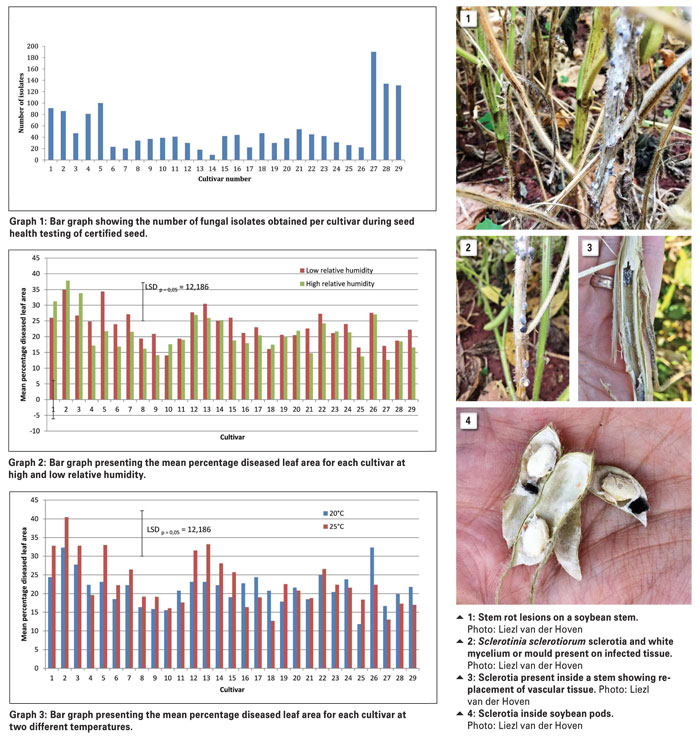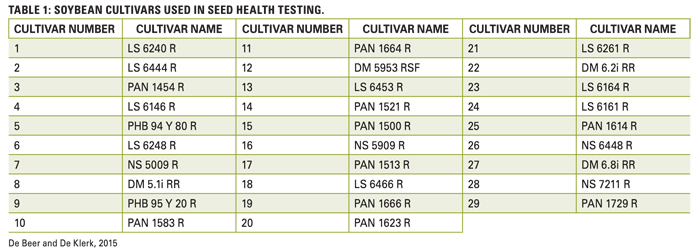September 2017
Sclerotinia sclerotiorum is a fungus that feeds on soybean tissue, causing stem rot of soybean. This fungus is found all over the world and it has a wide range of host species including important South African crops like soybean, sunflower and canola.
The fungus thrives in wet and cold conditions and can result in extreme yield losses under favourable environmental conditions. The stem rot starts as a white mould growing on the surface of infected plants, as seen in Photo 1 and Photo 2.
Water-soaked lesions then follow and vascular tissue is replaced with fungal survival structures called sclerotia (Photo 3), causing wilting and death of plant cells. Sclerotia can also be found in soybean pods, as seen in Photo 4, possibly reducing the quality of seeds.
The cell death is known to be due to toxic substances, the main virulence factor being oxalic acid, which is secreted by the fungus. However, the mechanisms involved in this process are still unclear.

Seed testing
Losses caused by stem rot are mainly due to reduced seed quality and lower yields. Seed testing in terms of health, vigour and germination is thus important to assess quality of seeds marketed to customers.
Seed health is important as pathogens associated with soybean seeds can cause faster deterioration of seeds in storage, a rise in soil- and seed-borne inoculum, a decrease in seedling emergence or germination of seeds, or they could cause disease symptoms on mature plants, e.g. blights and leaf spots. Seed health testing will provide insights into which fungi are present in South African soybean seed, and whether some of these fungi are pathogenic on soybean.
The seed health of 29 different soybean cultivars (Table 1) was determined using a traditional incubation method. Possibly pathogenic fungal species isolated included Bipolaris, Chaetomium, Macrophomina and Fusarium species. Results from seed health testing are presented in Graph 1. Macrophomina phaseolina could possibly cause charcoal rot on soybean roots and stems.

The seed health was calculated by dividing the number of fungal isolates per cultivar by the 400 seeds tested and converted to a percentage. From the results of seed health testing, growers can choose the optimal cultivars for planting in each region, based on amounts of pathogenic microflora present in seed. This could prevent yield losses due to reduced seed-borne inoculum levels.
Germination tests are used to assess the quality of seeds, which has a direct influence on the productivity of crops. Seeds with lower vigour and viability usually have lower germination rates. Accelerated ageing is a vigour test commonly used for soybean where seeds are rapidly aged under conditions of high temperature and humidity. This test estimates the storage potential and field emergence of soybean.
In this study the normal germination percentages and accelerated ageing germination percentages of 29 soybean cultivars planted in South Africa were determined. From the results, it was found that cultivar LS 6161 R had the best normal germination, with a percentage of 96%. This cultivar’s accelerated ageing percentage was also very good at 86%.
PAN 1664 R was the cultivar with the lowest germination percentage of only 53%, as well as being the cultivar with the lowest accelerated ageing germination percentage of 34,5%.
Cultivars NS 5909 R and LS 6466 R showed accelerated ageing germination percentages higher than the normal germination percentages, demonstrating that these cultivars have good vigour, and should still have relatively good germination at high temperatures and relative humidity.
The highest accelerated ageing germina tion percentage of 89% was recorded for cultivars PAN 1614 R and PAN 1729 R.
Resistance screening against S. sclerotiorum
Since stem rot caused by S. sclerotiorum can result in extensive damage, many control measures have been tested, including partial host resistance, but these have proven to be fairly ineffective. Due to the ineffectiveness of management practices like chemical control, biological control and cultural practices, the identification and/or development of cultivars that confer resistance to the pathogen could provide more effective disease management options.
The detached leaf assay has been used extensively and it has been found to be one of the best screening methods together with the oxalic acid based method. Detached leaf assays and an application calculating percentage diseased leaf area were used to screen the susceptibility of the 29 cultivars in Table 1 to S. sclerotiorum under different conditions of relative humidity and temperature and the results can be seen in Graph 2 and Graph 3.
Graph 2 indicates that cultivar LS 6444 R was the most susceptible to S. sclerotiorum at both high and low relative humidity and that cultivars DM 6.8i RR and PAN 1583 R were the most tolerant under high and low relative humidity, respectively.
Graph 3 indicates that NS 6448 R and LS 6444 R were the most susceptible cultivars at 20°C and 25°C respectively. Cultivars PAN 1614 R and LS 6466 R were the most tolerant cultivars at 20°C and 25°C respectively.
Overall, cultivars LS 6444 R, PAN 1454 R, LS 6240 R, LS 6453 R and PAN 1500 R were significantly more susceptible to S. sclerotiorum compared to other cultivars.
Considering the results, it is evident that certain cultivars should be selected by growers based on their ability to perform well under specific environmental conditions, and because of their seed quality.
If a grower experienced a Sclerotinia stem rot outbreak in previous years, it could be beneficial to select cultivars that are more tolerant to the pathogen while avoiding more susceptible cultivars, in order to manage a possible future outbreak.
Further research needs to be conducted in order to effectively manage the disease using cultivar selection, biological control agents, as well as integrated pest management.
Publication: September 2017
Section: Focus on